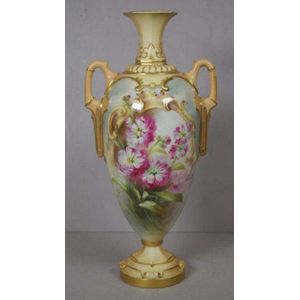Enamelled Silver Vase and Lotus Leaf Basket Set
An enamelled silver vase, by Masamitsu, Meiji period, the compressed body decorated with a profusion of flowers and foliage below the plain slender neck entwined with a snake, the base with a gilt plaque signed 'Masamitsu' and stamp 'jungin'; together with a lotus leaf form swing handled silver basket on three pod feet, the sides with copper and gilt flowers and insects and 'shakudo' beetle in 'takazogan', the base stamped with a seal, (2), 10 cm high, and 6 cm high
You must be a subscriber, and be logged in to view price and dealer details.
Subscribe Now to view actual auction price for this item
When you subscribe, you have the option of setting the currency in which to display prices to $Au, $US, $NZ or Stg.
This item has been sold, and the description, image and price are for reference purposes only.
- Shakudo - Japanese shakudo is a traditional alloy that has been used in Japan for centuries. It is primarily composed of copper and gold, with the copper serving as the base metal and the gold adding a yellowish hue to the alloy. Shakudo is known for its beautiful dark blue-black or black colour, which is achieved through the addition of a small amount of a patina-inducing element like silver or arsenic.
The word "shakudo" itself can be translated as "red copper" in Japanese, referring to the reddish-brown color of the pure copper base metal before it is patinated. The gold content in shakudo is usually around 4-10%, but this can vary depending on the specific purpose or desired appearance.
Shakudo has been traditionally used in various forms of decorative arts and crafts in Japan. It is particularly associated with metalwork, including sword fittings (such as tsuba, menuki, and kashira), jewelry, and small ornamental objects. The alloy's dark color provides a striking contrast to other metals like silver or gold, making it ideal for intricate inlay work or as a background for other decorative elements.
This item has been included into following indexes:
-
Chinese silver
- bowls and baskets 581
- vases 385
Visually similar items

Royal Worcester signed Frank Roberts vase, with hand painted phlox, circa 1907, 31.5 cm high
Sold by
in
for
You can display prices in $Au, $US, $NZ or Stg.

Antique sterling silver condiment jug, Birmingham 1905-06 approx 12 cm high
Sold by
in
for
You can display prices in $Au, $US, $NZ or Stg.

Vintage Sheffield Plate wine bucket with lion head handles, metal date brass dated 1958, 24 cm high
Sold by
in
for
You can display prices in $Au, $US, $NZ or Stg.

Grainer Worcester mantel urn ovoid body painted with pheasants on peach ground, signed Jas. Stinton, 33.5 cm high
Sold by
in
for
You can display prices in $Au, $US, $NZ or Stg.
